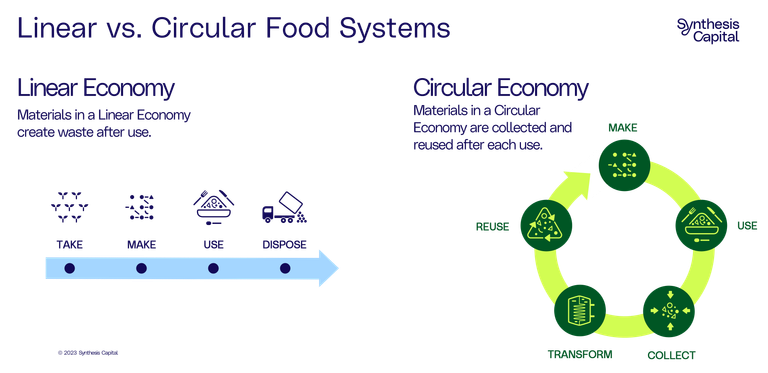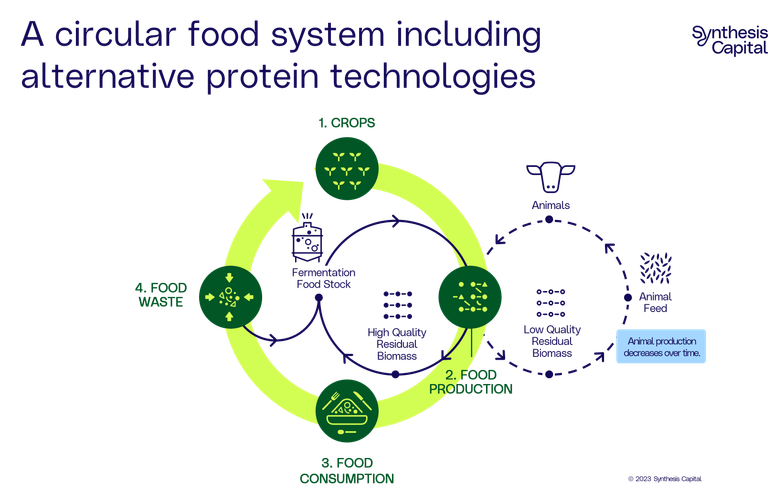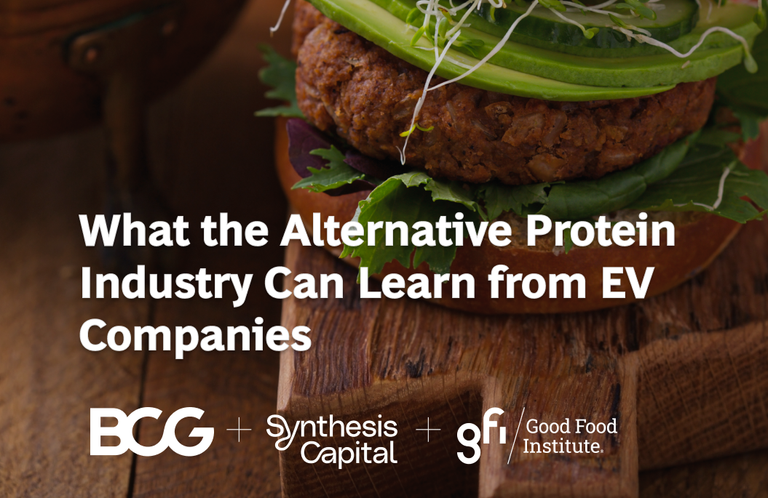From Linear to Circular: How Alternative Proteins and a Circular Food System Can Help Feed the Planet
• Market Update • Technology • Feature
How do we feed 10 billion people by 2050 within planetary boundaries? This is one of the central questions driving our work at Synthesis Capital.
A sustainable, healthy, and just food system will be challenging, if not impossible, to achieve without implementing circularity principles. A circular food system is a critical component of a broader circular bioeconomy and aims to shift from our current linear system of “extract-produce-consume-discard”1 to a system that minimizes the amount of waste generated, recycles and upcycles side-streams and food waste, increases food system resilience through input diversification, enables regenerative production (growing food that generates positive outcomes for nature2), and transitions the global population to a more efficient, lower impact diet3 (Figure 1).

Our current linear food system is the biggest cause of global environmental change. Agriculture uses half of all habitable land4 and accounts for 70% of global freshwater withdrawals5, while food production accounts for more than a quarter of global greenhouse gas emissions6. A growing population with an increasing demand for animal-sourced food7 coupled with climate-driven crop yield reductions8 means we will be unable to feed the earth’s population within planetary boundaries. A paradigm shift to a sustainable, circular food system is urgently needed.
Circular food systems optimally allocate planetary resources in production of food, and therefore the production of plants for human consumption is prioritised, rather than for fuel or animal feed. The success of a circular food system is dependent on the efficient use of land to grow biomass and the optimal processing and utilisation of that biomass.
The shift to a
more sustainable food system requires a significant reduction in the
consumption of animal products and a transition away from intensive
agricultural practices that negatively impact the planet. In the long term, we
expect alternative protein technologies to supply the majority of meat, egg,
and dairy products, but this protein transition
will not happen overnight. To mitigate the impact of the food system on the environment
while this transition occurs, we need to implement a circular food system for
both animal-derived and non-animal-derived food.
In 2022, a group from Wageningen University assessed the effect of a circular food system on a reference diet published by EAT-Lancet, which contains increased quantities of food from plants and decreased amounts of food from animals9. Van Selm and colleagues modelled three scenarios where animals were fed co-products and food waste (low-cost biomass) from the plant-sourced section (i.e. whole grains, fruits, vegetables, legumes, tree nuts, vegetable oils) of the EAT-Lancet reference diet10. Two of the scenarios used the fixed composition of animal-based food specified in the EAT-Lancet guidelines and analysed the effects of a healthier wholegrain diet versus a refined grain diet. Consuming wholegrains is more optimal from a human health perspective but using refined grains results in additional by-products for animal feed. The third scenario used a wholegrain diet but looked at the effects of an unrestrained quantity of different sources of animal-based food to examine the production potential of different animals fed low-cost biomass.
How biomass is processed and used is central to the success of our food system (and a circular food system). Where we grow the biomass and how we manage land is foundational to food system efficiency. In a circular food system (Figure 1), crops are grown for human food consumption – both in the form of fresh and processed fruits and vegetables and as plant-based meat, egg, and dairy products that reduce demand for animal-derived products. Residual crop biomass and food waste – depending on quality and safety – are returned to the soil, fed to animals, or used to power fermentation and cultivation processes. The latter producing food ingredients and end-products as well as chemicals and biomaterials that further reduce the need for animals within the food system and other sectors (Figure 2).

Van Selm et al. demonstrated that feeding low-cost biomass to animals (rather than growing crops specifically for animal feed) can reduce greenhouse gas emissions and land use while supporting healthy and environmentally sustainable diets. While the authors did not discuss meat, egg, and dairy alternatives produced from plants, fermentation, and cultivation technologies, numerous studies demonstrate that a transition to these products will have a significant positive impact on greenhouse gas emissions, land use, water use, and eutrophication11,12,13,14,15. As these technologies scale, costs decrease further, and supply chains improve, the need for intensive animal agriculture and row crop production for animal feed will be removed. Combined with the circularity principles outlined in this paper, the role of animals can return to regenerative practices that are far less harmful to the planet and crops, land, and fermentation technologies can be used intelligently to power the bioeconomy.
At Synthesis, we view circularity as an integral part of a successful alternative protein industry and we’re already supporting companies developing technologies that will help shift the planet to a circular food system, including Perfect Day’s research on using the biomass from their recombinant whey protein production process as a sustainable pet food ingredient14 and Arkeon’s utilisation of CO2 to fuel the sustainable production of amino acids and proteins. We expect new companies to emerge with circularity principles at their core, and existing companies to implement circular manufacturing processes. In the long term, the most successful and impactful companies will collaborate across the broader bioeconomy to ensure land, natural resources, and side streams are used in the most efficient way possible.
In the long term, the most successful and impactful companies will collaborate across the broader bioeconomy to ensure land, natural resources, and side streams are used in the most efficient way possible.
References
1. Van Zanten HHE, Van Ittersum MK, De Boer IJM. The role of farm animals in a circular food system. Glob Food Secur. 2019;21:18-22. doi:10.1016/j.gfs.2019.06.003
2. The big food redesign. https://ellenmacarthurfoundati...
3. Jurgilevich A, Birge T, Kentala-Lehtonen J, et al. Transition towards Circular Economy in the Food System. Sustainability. 2016;8(1):69. doi:10.3390/su8010069
4. Ritchie H, Roser M. Land Use. Our World Data. Published online November 13, 2013. https://ourworldindata.org/lan...
5. of the United Nations F and AO. The State of the World’s Land and Water Resources for Food and Agriculture. 0 ed. Routledge; 2013. doi:10.4324/9780203142837
6. Poore J, Nemecek T. Reducing food’s environmental impacts through producers and consumers. Science. 2018;360(6392):987-992. doi:10.1126/science.aaq0216
7. Global meat consumption. Our World in Data. https://ourworldindata.org/gra...
8. Jägermeyr J, Müller C, Ruane AC, et al. Climate impacts on global agriculture emerge earlier in new generation of climate and crop models. Nat Food. 2021;2(11):873-885. doi:10.1038/s43016-021-00400-y
9. van Selm B, Frehner A, de Boer IJM, et al. Circularity in animal production requires a change in the EAT-Lancet diet in Europe. Nat Food. 2022;3(1):66-73. doi:10.1038/s43016-021-00425-3
10. Food in the Anthropocene: the EAT–Lancet Commission on healthy diets from sustainable food systems - The Lancet (18)31788-4/fulltext
11. Delay A. Comparison of Life Cycle Assessments of Grass Fed Beef, In Vitro Beef, and Plant Based Substitute Beef. Carthage College; 2020.
12. Mattick CS, Landis AE, Allenby BR, Genovese NJ. Anticipatory Life Cycle Analysis of In Vitro Biomass Cultivation for Cultured Meat Production in the United States. Env Sci Technol. 2015;49(19):11941-11949.
13. Smetana S, Mathys A, Knoch A, Heinz V. Meat alternatives: life cycle assessment of most known meat substitutes. Int J Life Cycle Assess. 2015;20(9):1254-1267.
14. Life Cycle Assessment of Perfect Day Protein. https://resources.perfectday.c...
15. Behm K, Nappa M, Aro N, et al. Comparison of carbon footprint and water scarcity footprint of milk protein produced by cellular agriculture and the dairy industry. Int J Life Cycle Assess. 2022;27(8):1017-1034. doi:10.1007/s11367-022-02087-0


